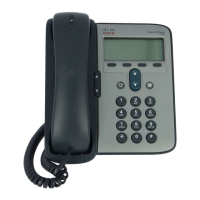Chapter 1 An Overview of the Cisco Unified IP Phone
What Networking Protocols Are Used?
1-6
Cisco Unified IP Phone 7906G and 7911G Administration Guide for Cisco Unified CallManager 5.1
OL-11515-01
HyperText Transfer
Protocol (HTTP)
HTTP is the standard way of
transferring information and moving
documents across the Internet and the
World Wide Web.
Cisco Unified IP Phones use HTTP
for the XML services and for
troubleshooting purposes.
IEEE 802.1X The IEEE 802.1X standard defines a
client-server-based access control
and authentication protocol that
restricts unauthorized clients from
connecting to a LAN through
publicly accessible ports.
Until the client is authenticated,
802.1X access control allows only
Extensible Authentication Protocol
over LAN (EAPOL) traffic through
the port to which the client is
connected. After authentication is
successful, normal traffic can pass
through the port.
The Cisco Unified IP Phone
implements the IEEE 802.1X
standard by providing support for the
EAP-MD5 option for 802.1X
authentication.
When 802.1X authentication is
enabled on the phone, you should
disable the PC port and voice VLAN.
See the
“Supporting 802.1X
Authentication on Cisco Unified IP
Phones” section on page 1-19 for
additional information.
Internet Protocol (IP) IP is a messaging protocol that
addresses and sends packets across
the network.
To communicate using IP, network
devices must have an assigned IP
address, subnet, and gateway.
IP addresses, subnets, and gateways
identifications are automatically
assigned if you are using the
Cisco
Unified IP Phone with
Dynamic Host Configuration
Protocol (DHCP). If you are not
using DHCP, you must manually
assign these properties to each phone
locally.
Table 1-1 Supported Networking Protocols on the Cisco Unified IP Phone (continued)
Networking Protocol Purpose Usage Notes

